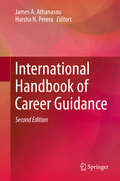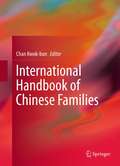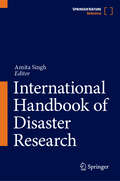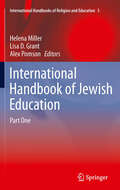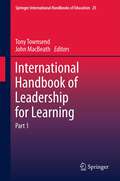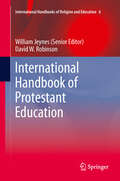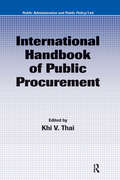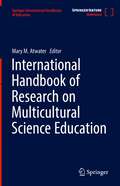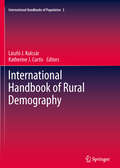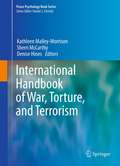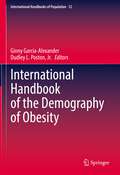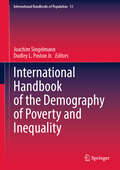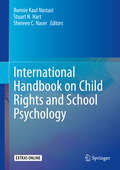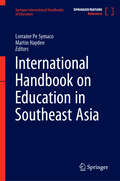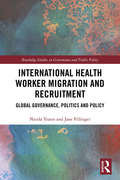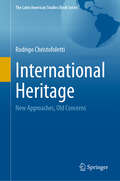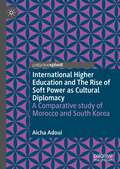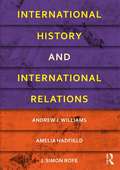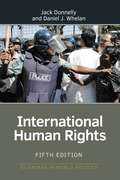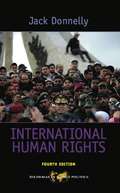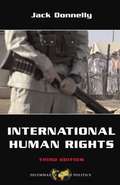- Table View
- List View
International Handbook of Career Guidance
by James A. Athanasou Harsha N. PereraThis handbook offers a comprehensive review on career guidance, with an emphasis on the applied aspects of guidance together with research methods and perspectives. It features contributions from more than 30 leading authorities in the field from Asia, Africa, America, Australasia and Europe and draws upon a wide range of career guidance paradigms and theoretical perspectives. This handbook covers such subjects as educational and vocational guidance in a social context, theoretical foundations, educational and vocational guidance in practice, specific target groups, testing and assessment, and evaluation.
International Handbook of Chinese Families
by Chan Kwok-BunFamilies are the cornerstone of Chinese society, whether in mainland China, in Taiwan, Hong Kong, Macao, Singapore, Malaysia, or in the Chinese diaspora the world over. Handbook of the Chinese Family provides an overview of economics, politics, race, ethnicity, and culture within and external to the Chinese family as a social institution. While simultaneously evaluating its own methodological tools, this book will set current knowledge in the context of what has been previously studied as well as future research directions. It will examine inter-family relationships and politics as well as childrearing, education, and family economics to provide a rounded and in-depth view.
International Handbook of Disaster Research
by Amita SinghThis handbook is a comprehensive source of information, analysis and directions in disaster studies. It goes beyond the oft-explored issues of management and science related to the topic and explores policies, governance, law and decision-making combined with the processes of implementation and enforcement, all the while integrating the latest science and technology updates related to the topic, such as artificial intelligence and early warning systems. It brings together studies which relate to sociology, politics and institutional economics, which work under the impact of resource availability, issues of leadership and international laws. Disasters are trans-boundary and disaster studies are trans-disciplinary. It is this aspect which would form the fulcrum of contributions and present a new, refreshing and innovative design for the handbook. The transformatory pedagogy which started with the Hyogo Framework for action 2005-2015 and The Sendai Framework for Disaster Risk Reduction 2015-2030 outlines seven clear targets and four priorities for action to prevent new and reduce existing disaster risks. The four priority areas around which the book would revolve are (i) Understanding disaster risk; (ii) Strengthening disaster risk governance to manage disaster risk; (iii) Investing in disaster reduction for resilience and; (iv) Enhancing disaster preparedness for effective response, and to "Build Back Better" in recovery, rehabilitation and reconstruction.
International Handbook of Jewish Education
by Alex Pomson Lisa D. Grant Helena MillerThe International Handbook of Jewish Education, a two volume publication, brings together scholars and practitioners engaged in the field of Jewish Education and its cognate fields world-wide. Their submissions make a significant contribution to our knowledge of the field of Jewish Education as we start the second decade of the 21st century. The Handbook is divided broadly into four main sections: Vision and Practice: focusing on issues of philosophy, identity and planning -the big issues of Jewish Education.Teaching and Learning: focusing on areas of curriculum and engagementApplications, focusing on the ways that Jewish Education is transmitted in particular contexts, both formal and informal, for children and adults.Geographical, focusing on historical, demographic, social and other issues that are specific to a region or where an issue or range of issues can be compared and contrasted between two or more locations.This comprehensive collection of articles providing high quality content, constitutes a difinitive statement on the state of Jewish Education world wide, as well as through a wide variety of lenses and contexts. It is written in a style that is accessible to a global community of academics and professionals.
International Handbook of Leadership for Learning
by John Macbeath Tony TownsendThe International Handbook of Leadership for Learning brings together chapters by distinguished authors from thirty-one countries in nine different regions of the world. The handbook contains nine sections that provide regional overviews; a consideration of theoretical and contextual aspects; system and policy approaches that promote leadership for learning with a focus on educating school leaders for learning and the role of the leader in supporting learning. It also considers the challenge of educating current leaders for this new perspective, and how leaders themselves can develop leadership for learning in others and in their organisations, especially in diverse contexts and situations. The final chapter considers what we now know about leadership for learning and looks at ways this might be further improved in the future. The book provides the reader with an understanding of the rich contextual nature of learning in schools and the role of school leaders and leadership development in promoting this. It concludes that the preposition 'for' between the two readily known and understood terms of 'leadership' and 'learning' changes everything as it foregrounds learning and complexifies, rather than simplifies, what that word may mean. Whereas common terms such as 'instructional leadership' reduce learning to 'outcomes', leadership for learning embraces a much wider, developmental view of learning.
International Handbook of Population Policies (International Handbooks of Population #11)
by Jack A. Goldstone John F. MayThis Handbook offers an array of internationally recognized experts’ essays that provide a current and comprehensive examination of all dimensions of international population policies. The book examines the theoretical foundations, the historical and empirical evidence for policy formation, the policy levers and modelling, as well as the new policy challenges. The section Theoretical Foundations reviews population issues today, population theories, the population policies’ framework as well as the linkages between population, development, health, food systems, and the environment. The next section Empirical Evidence discusses international approaches to design and implement population policies on a regional level. The section Policy Levers and Modelling reviews the tools and the policy levers that are available to design, implement, monitor, and measure the impact of population policies. Finally, the section New Policy Challenges examines the recurrent and emerging issues in population policies. This section also discusses prospects for demographic sustainability as well as future considerations for population policies. As such this Handbook provides an important and structured examination of contemporary population policies, their evolution, and their prospects.
International Handbook of Protestant Education
by William Jeynes David W. RobinsonSince their earliest days, institutions providing a Protestant education have always been respected and sought-after for their rigor and relative freedom from dogma--and despite today's secularism and plurality, they remain so. This international handbook is the ultimate companion to protestant schooling worldwide. Its 39 chapters form the most comprehensive and wide-ranging treatment of the subject yet available, addressing Protestant education on all six inhabited continents and featuring the perspectives of leading authorities and public figures. The contributions cover in detail not only the facts and features of Protestant schooling in sundry nations, but also integrate a range of themes common to them all, themes so vital that they are of central concern to Christians around the world and of whatever denomination. Some of these topics are school choice, globalization, Bible pedagogy and character education, the fine arts, parental involvement, and the rise of Christianity in previously inaccessible locations such as China. The handbook's stellar list of authors is a Who's Who of authorities on the subject and includes a renowned American evangelical, a former historian of the US House of Representatives, and White House consultants responsible for framing legislation. The many contributors from outside the USA are leading academics conducting seminal research on numerous topics in the field. Both exhaustive and authoritative, The International Handbook of Protestant Educationwill be an invaluable asset to educators, ministers, parents, policy makers political leaders of any denomination--or none.
International Handbook of Public Procurement (Public Administration and Public Policy #146)
by Khi V. ThaiSince the 1990s, government at all levels is under increasing pressure to do more with less. However, despite the U.S. government spending about 15 to 20 percent of its GDP on contracts for goods and services, there is a paucity of reference books for public procurement officials and very few textbooks for courses on the subject. Filling this void, the International Handbook of Public Procurement provides the knowledge necessary to understand how procurement works and how to improve the cost-effectiveness of procurement systems. Taking a multidisciplinary approach, the book focuses on the managerial, economic, political, and legal aspects of this topic. It begins with a conceptual framework and highlights various reforms occurring in certain countries. By examining these improvements, readers are able to apply this knowledge to their own strategies. The next section presents selected cases that illustrate the public procurement process, examining systems in various nations including Germany, China, South Africa, Cambodia, Uganda, and Estonia. The book also discusses the rise of electronic procurement systems (E-procurement) and reviews the benefits of these efficient systems. Other topics presented in this comprehensive volume include practical discussions on contract negotiations, bidding, price strategies and cost analysis, and an insightful chapter on the market’s response to contract award announcements. A virtual encyclopedia from numerous international experts, this book was assembled by Khi V. Thai, Professor at Florida Atlantic University and Editor of the Journal of Public Procurement. Dr. Thai has provided technical assistance in the area of public procurement to governments across the world. Empowering those on all sides of the issue, this volume dispenses advice valuable to government officials and contractors, as well as providing a comprehensive text for public administration students.
International Handbook of Research on Multicultural Science Education (Springer International Handbooks of Education)
by Mary M. AtwaterThis handbook gathers in one volume the major research and scholarship related to multicultural science education that has developed since the field was named and established by Atwater in 1993. Culture is defined in this handbook as an integrated pattern of shared values, beliefs, languages, worldviews, behaviors, artifacts, knowledge, and social and political relationships of a group of people in a particular place or time that the people use to understand or make meaning of their world, each other, and other groups of people and to transmit these to succeeding generations. The research studies include both different kinds of qualitative and quantitative studies. The chapters in this volume reflect differing ideas about culture and its impact on science learning and teaching in different K-14 contexts and policy issues. Research findings about groups that are underrepresented in STEM in the United States, and in other countries related to language issues and indigenous knowledge are included in this volume.
International Handbook of Rural Demography
by László J. Kulcsár Katherine J. CurtisThis is the third in an essential series of Springer handbooks that explore key aspects of the nexus between demography and social science. With an inclusive international perspective, and founded on the principles of social demography, this handbook shows how the rural population, which recently dropped below 50 per cent of the world total, remains a vital segment of society living in proximity to much-needed developmental and amenity resources. The rich diversity of rural areas shapes the capacity of resident communities to address far-reaching social, environmental and economic challenges. Some will survive, become sustainable and even thrive, while others will suffer rapid depopulation. This handbook demonstrates how these future development trajectories will vary according to local characteristics including, but not limited to, population composition. The growing complexity of rural society is in part a product of significant international variations in population trends, making this comparative and comprehensive study of rural demography all the more relevant. Collating the latest research on international rural demography, the handbook will be an invaluable aid to policy makers as they try to understand how demographic dynamics depend on the economic, social and environmental characteristics of rural areas. It will also aid researchers assessing the unique factors at play in the rural context and endeavoring to produce meaningful results that will advance policy and scholarship. Finally, the handbook is an ideal text for graduate students in a spread of disciplines from sociology to international development.
International Handbook of War, Torture, and Terrorism
by Kathleen Malley-Morrison Denise Hines Sherri MccarthyInternational Handbook of Reconciliation and Negotiation follows up on the research gathered from the PAIRTAPS (Perspectives on Govermental Aggression and Peace) survey that was administered in over 40 countries worldwide. Where the International Handbook of Government Aggression and Peace focuses on governmental acts of aggression and violence, this book highlights the many actions taken worldwide to secure the rights of individuals to peace and protest, as examined from a theoretical standpoint. The book has both a theory base as well as empirical findings that should appeal to researchers across several disciplines including peace psychology, political science, and sociology.
International Handbook of the Demography of Obesity (International Handbooks of Population #12)
by Dudley L. Poston Ginny Garcia-AlexanderThis handbook provides a demographic examination of global obesity trends by bringing together the range of research conducted in this field by demographers, sociologists, epidemiologists, and other quantitatively and demographically oriented social scientists. It utilizes a multidisciplinary demographic approach to provide insights into the global prevalence and mechanisms of obesity, as well as the population level impacts of rising obesity. Major sections include: global obesity trends and prevalence; obesity and demographic structures, processes, and characteristics; emerging areas of study; and obesity in LGBAT populations. This handbook provides readers with a broad understanding of population-based research on obesity and serves as a resource for scholars, students, policymakers, and researchers.
International Handbook of the Demography of Poverty and Inequality (International Handbooks of Population #13)
by Dudley L. Poston Jr. Joachim SingelmannThis handbook provides a comprehensive and comparative review of poverty and inequality in developing and developed countries from demographic, sociological, and political perspectives. It discusses, among others, the basics of poverty and inequality, issues of poverty and inequality among race/ethnic and sexual minority subpopulations, social processes, country and comparative perspectives, child poverty, and anti-poverty policies. It also touches on regional disparities. There has been rapid decline in poverty and inequality in China, East Asian and Pacific countries. Declines have also occurred in South Asia. But in Sub-Saharan Africa, poverty and inequality have risen in some countries, while in other regions, such as transition economies in Europe and Central Asia, only modest changes have occurred. This handbook provides a great reference for demographers, social scientists, policy makers and NGOs.
International Handbook on Child Rights and School Psychology
by Bonnie Kaul Nastasi Stuart N. Hart Shereen C. NaserThis handbook examines the meanings, implications, and transformative potential of a child-rights approach for school psychology. It focuses on the school community, in which psychology is committed to promoting well-being, learning, and development of all children. The handbook begins with an overview of the 1989 United Nations Committee on the Rights of the Child (CRC) and explores main themes such as, survival, protection, development, participation, and nondiscrimination. Chapters provide guidance in promoting and protecting child rights when dealing with critical issues relevant to the school community, including well-being, freedom from violence, and access to high quality education. In addition, chapters analyze and offer recommendations for child rights applications within the roles and responsibilities of school psychologists. The handbook concludes with future directions for achieving a child-rights approach for school psychology. Topics featured in this handbook include:The current status of child rights in the international community.Accountability for child rights by school psychology.Collaborative home, school, and community practices aimed at promoting family support.Protecting child rights within the realm of competitive sports.CRC and school-based intervention programming.Promoting child rights through school leadership.Applying child rights-respecting research to the study of psychological well-being. The International Handbook on Child Rights and School Psychology is a must-have resource for researchers, scientist-practitioners, clinicians, and graduate students in child and school psychology, educational policy and politics, social work, public health, and other school-based or child-serving mental health disciplines.
International Handbook on Education in Southeast Asia (Springer International Handbooks of Education)
by Martin Hayden Lorraine Pe SymacoThis International Handbook provides a detailed account of the education systems of 11 Southeast Asian nations, including Brunei Darussalam, Cambodia, Indonesia, Lao People’s Democratic Republic, Malaysia, Myanmar, the Philippines, Singapore, Thailand, Timor- Leste, and Vietnam. It presents a systematic sector-by-sector explanation of how these national education systems deliver educational services and respond to national and international issues and challenges. With 56 chapters, the International Handbook is the region’s most comprehensive educational reference source. In the first of its chapters, the editors introduce the regional context and draw attention to the distinctive characteristics of each of the 11 systems. Southeast Asia, representing 8.5% of the world’s population, is as dynamic as it is diverse. The International Handbook charts progress and establishes a benchmark for documenting future developments. It also provides a stepping-off point for more detailed investigations of decision-making processes and outcomes across the 11 national education systems.
International Health Worker Migration and Recruitment: Global Governance, Politics and Policy (Routledge Studies in Governance and Public Policy)
by Nicola Yeates Jane PillingerThis book is the first comprehensive study of international health worker-migration and -recruitment from the perspective of global governance, policy and politics. Covering 70 years of history of the development of this global policy field, this book presents new and previously unpublished data, based on primary research, to reveal for the first time that international health worker-migration-and -recruitment have been major concerns of global policy-making going back to the foundations of post-war international cooperation. The authors analyse the policies and programmes of a wide range of international organisations, from WHO, ILO and UNESCO to the IOM, World Bank and OECD, and feature extended analysis of bilateral agreements to manage health worker migration and recruitment, critiquing the claim that they work in the interests of all countries. Yeates’ and Pillinger’s ground-breaking analysis of global governance presents an assiduously researched study showing how the interplay and intersections of several global institutional regimes – spanning labour, migration, health, social protection, trade and business, equality and human rights – shape global policy responses to this major health care issue that affects all countries worldwide. It discusses the growing challenges to public health as a result of the globalisation of health labour markets, and highlights how global and national policy can realise the health and health-related Sustainable Development Goals for all by 2030. This research monograph will be of key interest to students and scholars of Global Governance, Global Public Policy, Global Health, Global Politics, Migration Studies, Health and Social Care, Social Policy and Development Studies. Policy makers and campaign activists, nationally and globally, will appreciate the practical relevance and applications of the research findings.
International Heritage: New Approaches, Old Concerns (The Latin American Studies Book Series)
by Rodrigo ChristofolettiThis book celebrates decades of safeguarding cultural heritage and reckons with reconfigurations and shifts that have shaped the field and understandings of it. The author reflects on a career of safeguarding heritage, offering perspectives from the positions of consumer, researcher, educator, and communicator and at a range of scales, from local-level debates to macro-level perspectives on the role of heritage preservation in international relations. The book situates heritage preservation in the context of soft power and the international system and examines how it intersects with cultural diplomacy. These interrelationships crystalize in the illicit trafficking of cultural goods, inspiring reflections on private and common goods, interoperability, and decoloniality. Grounded in nuanced understandings of "world heritage" and "heritage of humanity", the author critically examines the foundation, trajectory, and remit of UNESCO and highlights cases of cultural and natural heritage, language, and tourism. These discussions in turn inform treatments of two timely topics: intangible heritage of and for refugees and the treatment of statues and symbols of colonizers. By integrating diverse themes that are frequently treated independently, International Heritage: New Approaches, Old Concerns is a resource for researchers and practitioners looking to understand the foundations, current debates, and imminent challenges facing communities that aim to safeguard global cultural heritage.
International Higher Education and The Rise of Soft Power as Cultural Diplomacy: A Comparative study of Morocco and South Korea
by Aicha AdouiThis book offers a comprehensive analysis of international higher education and soft power as cultural diplomacy, through a study of Morocco and South Korea. It draws on extensive original research to explore the social, political, and economic factors that have shaped the international standing of both countries in terms of higher education. The research reveals the importance of higher education in promoting soft power and the role of international universities in enhancing the international reputation of a country. The book's key findings demonstrate the impact of soft power as cultural diplomacy on international relations and the contribution it makes to research in the field of international higher education.
International Higher Education in Citizen Diplomacy: Examining Student Learning Outcomes from Mobility Programs (International and Development Education)
by Shingo HanadaThis volume presents the impacts of international higher education on citizen diplomacy. Based on the assumption that international higher education is a key driving factor of citizen diplomacy, the empirical studies in this book examine the learning outcomes of five mobility programs of international higher education(inbound study abroad, outbound study abroad, international service-learning, international internship, and online study abroad) in cultivating students’ intercultural competence, empathy and goodwill towards people in the host country. It contributes to increasing awareness of international higher education by providing insights about its functions in citizen diplomacy.
International History and International Relations
by J. Simon Rofe Andrew J. Williams Amelia HadfieldThis innovative new textbook seeks to provide undergraduate students of international relations with valuable and relevant historical context, bridging the gap and offering a genuinely interdisciplinary approach. Each chapter integrates both historical analysis and literature and applies this to an international relations context in an accessible fashion, allowing students to understand the historical context in which these core issues have developed. The book is organised thematically around the key issues in international relations such as war, peace, sovereignty, identity, empire and international organisations. Each chapter provides an overview of the main historical context, theories and literature in each area and applies this to the study of international relations. Providing a fresh approach, this work will be essential reading for all students of international relations and international relations theory.
International Housing Market Experience and Implications for China (Routledge Studies in International Real Estate)
by Bertrand Renaud Rebecca L. Chiu Zhi LiuRecent rapid housing market expansion in China is presenting new challenges for policy makers, planners, business people, and citizens. Now that housing in middle-income China is driven by consumer choices and is no longer dominated by state policy decisions, housing policy issues in Chinese cities are becoming increasingly similar to those encountered in other global housing markets. With soaring prices and imbalances in housing supply favoring high income groups and housing demand driven by rising inequality in household incomes, many middle and lower-income households face worsening choices in terms of the quality and location of their housing as well as greater financial difficulties, which together can have negative implications for standards of public health. This book examines the impact of these changes on the general population, as well as on aspiring homeowners and developers. The contributors look at the effect on the widening of wealth gaps, slower economic growth, and threats to political and social stability. Though focusing on China, the editors also present discussions of specific policy design challenges encountered in Australia, Japan, Korea, the Netherlands, the Nordic countries, Singapore, Taiwan, the UK, and the US. This book would be of interest to housing policy makers, as well as academics who are studying the social and political effects of the Chinese housing market.
International Human Rights
by Jack Donnelly Daniel J. WhelanInternational Human Rights examines the ways in which states and other international actors have addressed human rights since the end of World War II. This unique textbook features substantial attention to theory, history, international and regional institutions, and the role of transnational actors in the protection and promotion of human rights. Its purpose is to explore the difficult and contentious politics of human rights, and how those political dimensions have been addressed at the national, regional, and especially international levels. The fifth edition is substantially updated, rewritten, and revised throughout, including updates on multilateral institutions (especially the UN's Universal Periodic Review process and the Human Rights Council's Special Procedures mechanisms), regional systems, human rights in foreign policy (including a specific chapter on U.S. foreign policy), humanitarian intervention and the "responsibility to protect," and (anti)terrorism and human rights. The book also includes a new chapter on the unity (indivisibility) of human rights. Chapters include discussion questions, case studies for in-depth examination of topics (including new case studies on the U.N. Special Procedures, Myanmar, and Israeli settlements in West-Bank Palestine), and ten "problems" (including new entries on the war in Syria and hierarchies between human rights) tailored to promote classroom discussion.
International Human Rights
by Jack DonnellyInternational Human Rightsstudies the ways in which states and other international actors have addressed human rights since the end of World War II. This unique textbook features substantial attention to the domestic politics of human rights, as well as an extensive emphasis on theory. The fourth edition is substantially rewritten and reorganized to enhance usability, and new material is added to bring the text up to date. Most notably, the sections covering multilateral, bilateral, and transnational action have been broken into seven short chapters, which encourage comparisons within and across types of action and historical cases. New case studies provide context and points of comparison, including a new examination of the contemporary international reactions to human rights violations in China now that the country has become a great power. Additionally, nine “Problems” have been added to the text, which along with the chapter-ending discussion questions, frame alternative interpretations, highlight controversies, and ultimately aim to provoke further thought and discussion amongst readers. International Human Rights,Fourth Edition, is the most current and comprehensive text available that will allow readers to understand how and why human rights are violated, what international action can do to address these violations, and why human rights remain such a small part of international relations.
International Human Rights
by Jack DonnellyThe question often asked is 'where is a good starting place for learning about international human rights?' The answer now is Donnelly's International Human Rights. Eminently readable, chock-full of information, Donnelly's book is a must-read. (Human Rights Quarterly) In this new edition, Jack Donnelly updates his classic text on the rise of human rights issues since World War II to reflect the new challenges posed by globalization and the war on terrorism. The third edition includes two entirely new chapters on the Universality of Human Rights and Terrorism, and focuses on the recent emergence of nonstate actors such as the UN and NGO's.
International Human Rights
by Jack DonnellyInternational Human Rights studies the ways in which states and other international actors have addressed human rights since the end of World War II. This unique textbook features substantial attention to the domestic politics of human rights, as well as an extensive emphasis on theory. The fourth edition is substantially rewritten and reorganized to enhance usability, and new material is added to bring the text up to date. Most notably, the sections covering multilateral, bilateral, and transnational action have been broken into seven short chapters, which encourage comparisons within and across types of action and historical cases. New case studies provide context and points of comparison, including a new examination of the contemporary international reactions to human rights violations in China now that the country has become a great power. Additionally, nine "Problems" have been added to the text, which along with the chapter-ending discussion questions, frame alternative interpretations, highlight controversies, and ultimately aim to provoke further thought and discussion amongst readers. International Human Rights, Fourth Edition, is the most current and comprehensive text available that will allow readers to understand how and why human rights are violated, what international action can do to address these violations, and why human rights remain such a small part of international relations.
